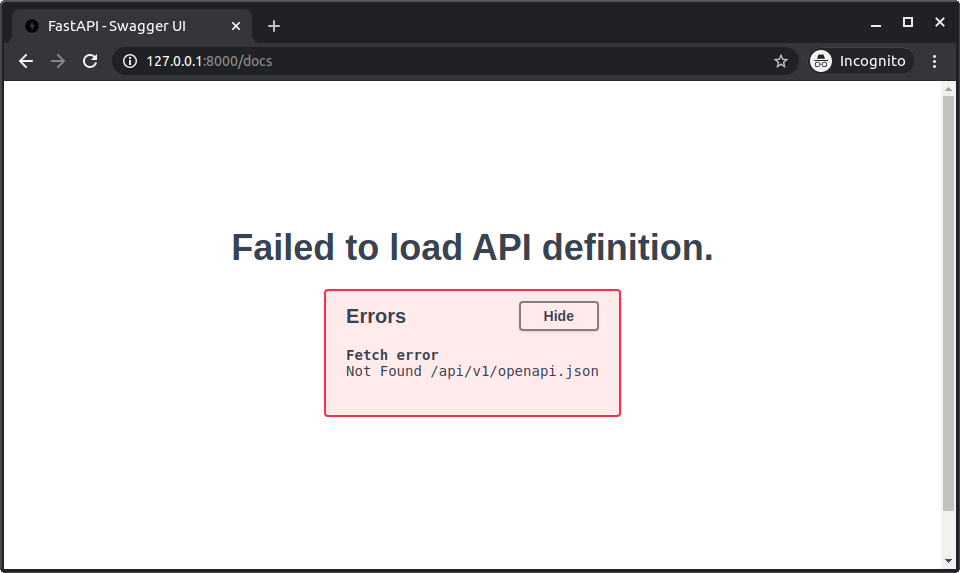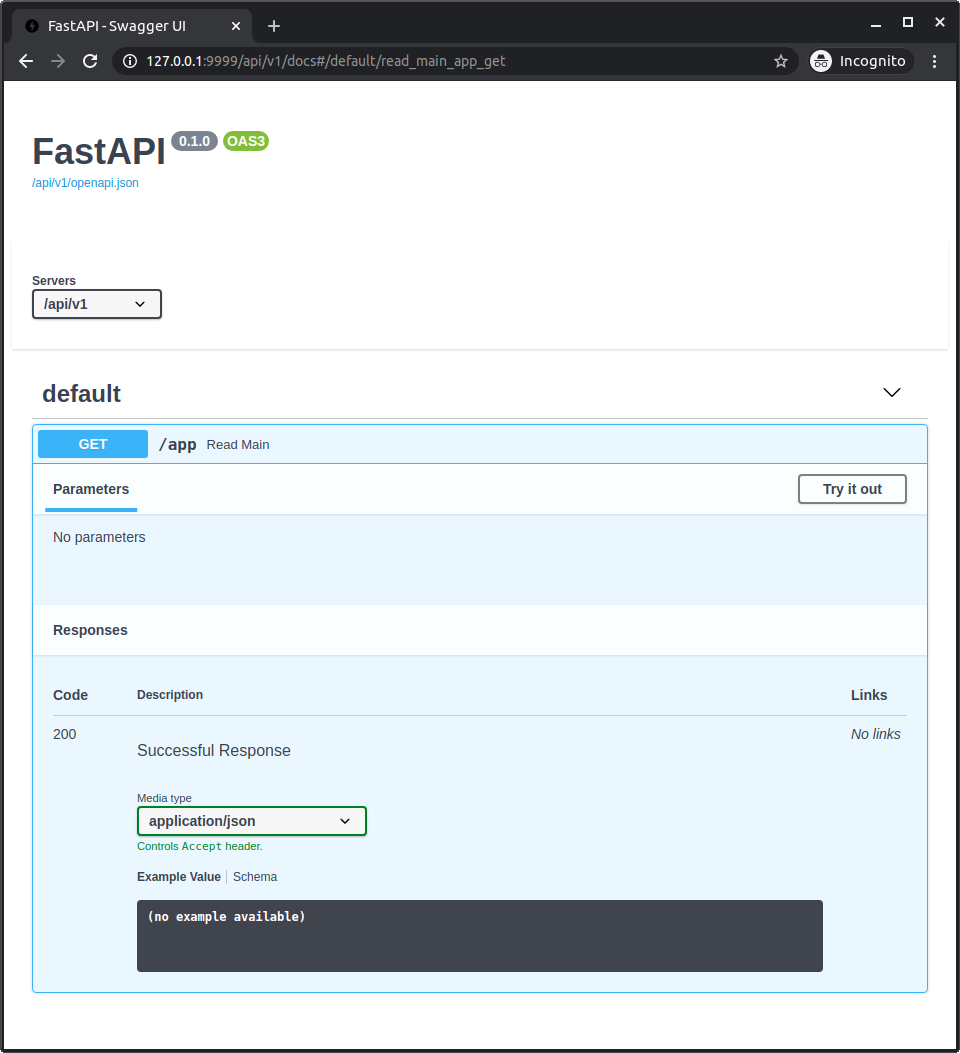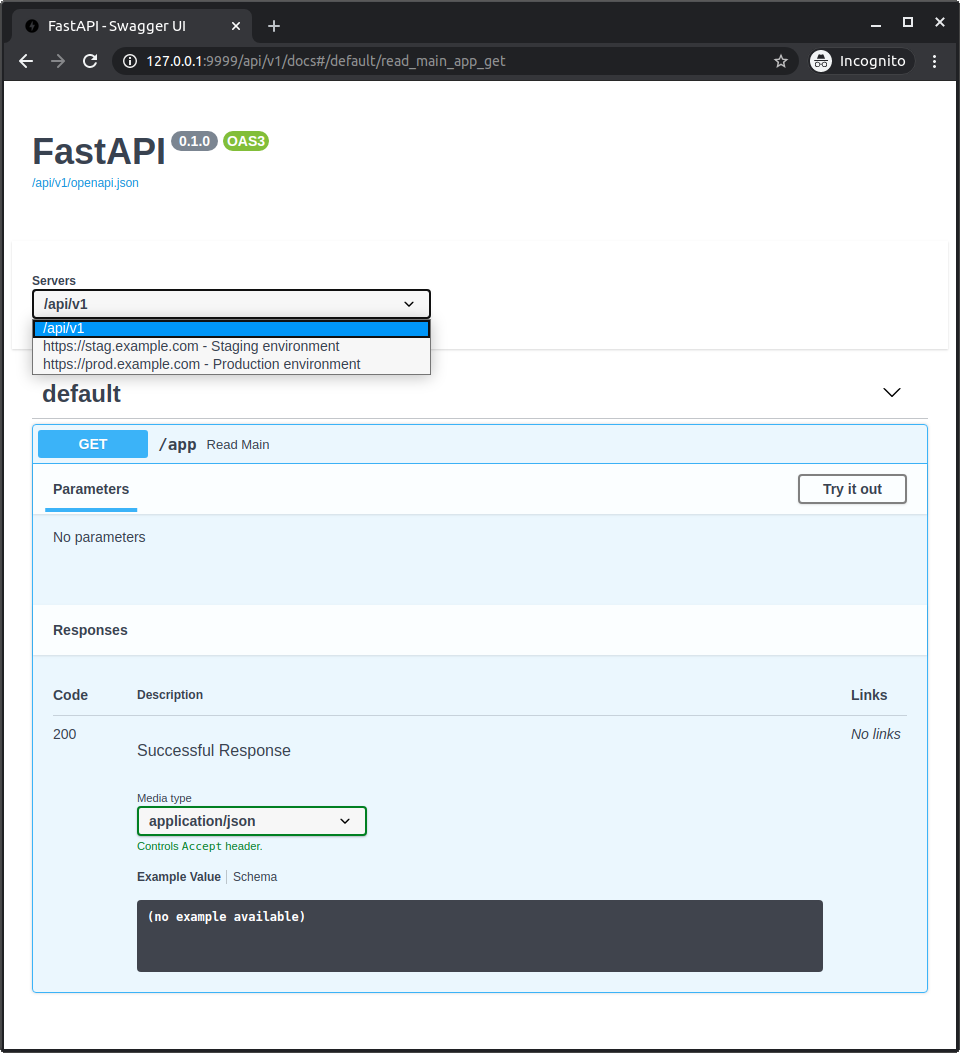Behind a Proxy¶
Warning
The current page still doesn't have a translation for this language.
But you can help translating it: Contributing.
In many situations, you would use a proxy like Traefik or Nginx in front of your FastAPI app.
These proxies could handle HTTPS certificates and other things.
Proxy Forwarded Headers¶
A proxy in front of your application would normally set some headers on the fly before sending the requests to your server to let the server know that the request was forwarded by the proxy, letting it know the original (public) URL, including the domain, that it is using HTTPS, etc.
The server program (for example Uvicorn via FastAPI CLI) is capable of interpreting these headers, and then passing that information to your application.
But for security, as the server doesn't know it is behind a trusted proxy, it won't interpret those headers.
Enable Proxy Forwarded Headers¶
You can start FastAPI CLI with the CLI Option --forwarded-allow-ips and pass the IP addresses that should be trusted to read those forwarded headers.
If you set it to --forwarded-allow-ips="*" it would trust all the incoming IPs.
If your server is behind a trusted proxy and only the proxy talks to it, this would make it accept whatever is the IP of that proxy.
$ fastapi run --forwarded-allow-ips="*"
<span style="color: green;">INFO</span>: Uvicorn running on http://127.0.0.1:8000 (Press CTRL+C to quit)
Redirects with HTTPS¶
For example, let's say you define a path operation /items/:
from fastapi import FastAPI
app = FastAPI()
@app.get("/items/")
def read_items():
return ["plumbus", "portal gun"]
If the client tries to go to /items, by default, it would be redirected to /items/.
But before setting the CLI Option --forwarded-allow-ips it could redirect to http://localhost:8000/items/.
But maybe your application is hosted at https://mysuperapp.com, and the redirection should be to https://mysuperapp.com/items/.
By setting --proxy-headers now FastAPI would be able to redirect to the right location. 😎
https://mysuperapp.com/items/
Tip
If you want to learn more about HTTPS, check the guide About HTTPS.
How Proxy Forwarded Headers Work¶
Here's a visual representation of how the proxy adds forwarded headers between the client and the application server:
sequenceDiagram
participant Client
participant Proxy as Proxy/Load Balancer
participant Server as FastAPI Server
Client->>Proxy: HTTPS Request<br/>Host: mysuperapp.com<br/>Path: /items
Note over Proxy: Proxy adds forwarded headers
Proxy->>Server: HTTP Request<br/>X-Forwarded-For: [client IP]<br/>X-Forwarded-Proto: https<br/>X-Forwarded-Host: mysuperapp.com<br/>Path: /items
Note over Server: Server interprets headers<br/>(if --forwarded-allow-ips is set)
Server->>Proxy: HTTP Response<br/>with correct HTTPS URLs
Proxy->>Client: HTTPS ResponseThe proxy intercepts the original client request and adds the special forwarded headers (X-Forwarded-*) before passing the request to the application server.
These headers preserve information about the original request that would otherwise be lost:
- X-Forwarded-For: The original client's IP address
- X-Forwarded-Proto: The original protocol (
https) - X-Forwarded-Host: The original host (
mysuperapp.com)
When FastAPI CLI is configured with --forwarded-allow-ips, it trusts these headers and uses them, for example to generate the correct URLs in redirects.
Proxy with a stripped path prefix¶
You could have a proxy that adds a path prefix to your application.
In these cases you can use root_path to configure your application.
The root_path is a mechanism provided by the ASGI specification (that FastAPI is built on, through Starlette).
The root_path is used to handle these specific cases.
And it's also used internally when mounting sub-applications.
Having a proxy with a stripped path prefix, in this case, means that you could declare a path at /app in your code, but then, you add a layer on top (the proxy) that would put your FastAPI application under a path like /api/v1.
In this case, the original path /app would actually be served at /api/v1/app.
Even though all your code is written assuming there's just /app.
from fastapi import FastAPI, Request
app = FastAPI()
@app.get("/app")
def read_main(request: Request):
return {"message": "Hello World", "root_path": request.scope.get("root_path")}
And the proxy would be "stripping" the path prefix on the fly before transmitting the request to the app server (probably Uvicorn via FastAPI CLI), keeping your application convinced that it is being served at /app, so that you don't have to update all your code to include the prefix /api/v1.
Up to here, everything would work as normally.
But then, when you open the integrated docs UI (the frontend), it would expect to get the OpenAPI schema at /openapi.json, instead of /api/v1/openapi.json.
So, the frontend (that runs in the browser) would try to reach /openapi.json and wouldn't be able to get the OpenAPI schema.
Because we have a proxy with a path prefix of /api/v1 for our app, the frontend needs to fetch the OpenAPI schema at /api/v1/openapi.json.
graph LR
browser("Browser")
proxy["Proxy on http://0.0.0.0:9999/api/v1/app"]
server["Server on http://127.0.0.1:8000/app"]
browser --> proxy
proxy --> serverTip
The IP 0.0.0.0 is commonly used to mean that the program listens on all the IPs available in that machine/server.
The docs UI would also need the OpenAPI schema to declare that this API server is located at /api/v1 (behind the proxy). For example:
{
"openapi": "3.1.0",
// More stuff here
"servers": [
{
"url": "/api/v1"
}
],
"paths": {
// More stuff here
}
}
In this example, the "Proxy" could be something like Traefik. And the server would be something like FastAPI CLI with Uvicorn, running your FastAPI application.
Providing the root_path¶
To achieve this, you can use the command line option --root-path like:
$ fastapi run main.py --forwarded-allow-ips="*" --root-path /api/v1
<span style="color: green;">INFO</span>: Uvicorn running on http://127.0.0.1:8000 (Press CTRL+C to quit)
If you use Hypercorn, it also has the option --root-path.
Technical Details
The ASGI specification defines a root_path for this use case.
And the --root-path command line option provides that root_path.
Checking the current root_path¶
You can get the current root_path used by your application for each request, it is part of the scope dictionary (that's part of the ASGI spec).
Here we are including it in the message just for demonstration purposes.
from fastapi import FastAPI, Request
app = FastAPI()
@app.get("/app")
def read_main(request: Request):
return {"message": "Hello World", "root_path": request.scope.get("root_path")}
Then, if you start Uvicorn with:
$ fastapi run main.py --forwarded-allow-ips="*" --root-path /api/v1
<span style="color: green;">INFO</span>: Uvicorn running on http://127.0.0.1:8000 (Press CTRL+C to quit)
The response would be something like:
{
"message": "Hello World",
"root_path": "/api/v1"
}
Setting the root_path in the FastAPI app¶
Alternatively, if you don't have a way to provide a command line option like --root-path or equivalent, you can set the root_path parameter when creating your FastAPI app:
from fastapi import FastAPI, Request
app = FastAPI(root_path="/api/v1")
@app.get("/app")
def read_main(request: Request):
return {"message": "Hello World", "root_path": request.scope.get("root_path")}
Passing the root_path to FastAPI would be the equivalent of passing the --root-path command line option to Uvicorn or Hypercorn.
About root_path¶
Keep in mind that the server (Uvicorn) won't use that root_path for anything else than passing it to the app.
But if you go with your browser to http://127.0.0.1:8000/app you will see the normal response:
{
"message": "Hello World",
"root_path": "/api/v1"
}
So, it won't expect to be accessed at http://127.0.0.1:8000/api/v1/app.
Uvicorn will expect the proxy to access Uvicorn at http://127.0.0.1:8000/app, and then it would be the proxy's responsibility to add the extra /api/v1 prefix on top.
About proxies with a stripped path prefix¶
Keep in mind that a proxy with stripped path prefix is only one of the ways to configure it.
Probably in many cases the default will be that the proxy doesn't have a stripped path prefix.
In a case like that (without a stripped path prefix), the proxy would listen on something like https://myawesomeapp.com, and then if the browser goes to https://myawesomeapp.com/api/v1/app and your server (e.g. Uvicorn) listens on http://127.0.0.1:8000 the proxy (without a stripped path prefix) would access Uvicorn at the same path: http://127.0.0.1:8000/api/v1/app.
Testing locally with Traefik¶
You can easily run the experiment locally with a stripped path prefix using Traefik.
Download Traefik, it's a single binary, you can extract the compressed file and run it directly from the terminal.
Then create a file traefik.toml with:
[entryPoints]
[entryPoints.http]
address = ":9999"
[providers]
[providers.file]
filename = "routes.toml"
This tells Traefik to listen on port 9999 and to use another file routes.toml.
Tip
We are using port 9999 instead of the standard HTTP port 80 so that you don't have to run it with admin (sudo) privileges.
Now create that other file routes.toml:
[http]
[http.middlewares]
[http.middlewares.api-stripprefix.stripPrefix]
prefixes = ["/api/v1"]
[http.routers]
[http.routers.app-http]
entryPoints = ["http"]
service = "app"
rule = "PathPrefix(`/api/v1`)"
middlewares = ["api-stripprefix"]
[http.services]
[http.services.app]
[http.services.app.loadBalancer]
[[http.services.app.loadBalancer.servers]]
url = "http://127.0.0.1:8000"
This file configures Traefik to use the path prefix /api/v1.
And then Traefik will redirect its requests to your Uvicorn running on http://127.0.0.1:8000.
Now start Traefik:
$ ./traefik --configFile=traefik.toml
INFO[0000] Configuration loaded from file: /home/user/awesomeapi/traefik.toml
And now start your app, using the --root-path option:
$ fastapi run main.py --forwarded-allow-ips="*" --root-path /api/v1
<span style="color: green;">INFO</span>: Uvicorn running on http://127.0.0.1:8000 (Press CTRL+C to quit)
Check the responses¶
Now, if you go to the URL with the port for Uvicorn: http://127.0.0.1:8000/app, you will see the normal response:
{
"message": "Hello World",
"root_path": "/api/v1"
}
Tip
Notice that even though you are accessing it at http://127.0.0.1:8000/app it shows the root_path of /api/v1, taken from the option --root-path.
And now open the URL with the port for Traefik, including the path prefix: http://127.0.0.1:9999/api/v1/app.
We get the same response:
{
"message": "Hello World",
"root_path": "/api/v1"
}
but this time at the URL with the prefix path provided by the proxy: /api/v1.
Of course, the idea here is that everyone would access the app through the proxy, so the version with the path prefix /api/v1 is the "correct" one.
And the version without the path prefix (http://127.0.0.1:8000/app), provided by Uvicorn directly, would be exclusively for the proxy (Traefik) to access it.
That demonstrates how the Proxy (Traefik) uses the path prefix and how the server (Uvicorn) uses the root_path from the option --root-path.
Check the docs UI¶
But here's the fun part. ✨
The "official" way to access the app would be through the proxy with the path prefix that we defined. So, as we would expect, if you try the docs UI served by Uvicorn directly, without the path prefix in the URL, it won't work, because it expects to be accessed through the proxy.
You can check it at http://127.0.0.1:8000/docs:

But if we access the docs UI at the "official" URL using the proxy with port 9999, at /api/v1/docs, it works correctly! 🎉
You can check it at http://127.0.0.1:9999/api/v1/docs:

Right as we wanted it. ✔️
This is because FastAPI uses this root_path to create the default server in OpenAPI with the URL provided by root_path.
Additional servers¶
Warning
This is a more advanced use case. Feel free to skip it.
By default, FastAPI will create a server in the OpenAPI schema with the URL for the root_path.
But you can also provide other alternative servers, for example if you want the same docs UI to interact with both a staging and a production environment.
If you pass a custom list of servers and there's a root_path (because your API lives behind a proxy), FastAPI will insert a "server" with this root_path at the beginning of the list.
For example:
from fastapi import FastAPI, Request
app = FastAPI(
servers=[
{"url": "https://stag.example.com", "description": "Staging environment"},
{"url": "https://prod.example.com", "description": "Production environment"},
],
root_path="/api/v1",
)
@app.get("/app")
def read_main(request: Request):
return {"message": "Hello World", "root_path": request.scope.get("root_path")}
Will generate an OpenAPI schema like:
{
"openapi": "3.1.0",
// More stuff here
"servers": [
{
"url": "/api/v1"
},
{
"url": "https://stag.example.com",
"description": "Staging environment"
},
{
"url": "https://prod.example.com",
"description": "Production environment"
}
],
"paths": {
// More stuff here
}
}
Tip
Notice the auto-generated server with a url value of /api/v1, taken from the root_path.
In the docs UI at http://127.0.0.1:9999/api/v1/docs it would look like:

Tip
The docs UI will interact with the server that you select.
Disable automatic server from root_path¶
If you don't want FastAPI to include an automatic server using the root_path, you can use the parameter root_path_in_servers=False:
from fastapi import FastAPI, Request
app = FastAPI(
servers=[
{"url": "https://stag.example.com", "description": "Staging environment"},
{"url": "https://prod.example.com", "description": "Production environment"},
],
root_path="/api/v1",
root_path_in_servers=False,
)
@app.get("/app")
def read_main(request: Request):
return {"message": "Hello World", "root_path": request.scope.get("root_path")}
and then it won't include it in the OpenAPI schema.
Mounting a sub-application¶
If you need to mount a sub-application (as described in Sub Applications - Mounts) while also using a proxy with root_path, you can do it normally, as you would expect.
FastAPI will internally use the root_path smartly, so it will just work. ✨